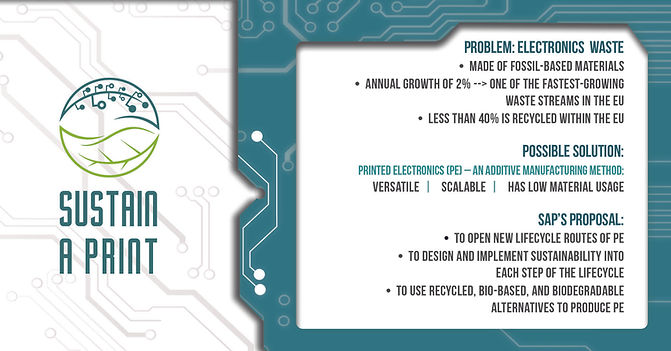

Sustainable materials and process for green printed electronics
Sustain-a-Print
Action 101070556

Coordinator
Duration
1/10/2022-31/9/2025
Budget
€ 4 135 317.50
Website
Project summary
Role of BikiarisLab
WP2 leader, synthesis of substates, recycling

Prompted by the dire forecasts for increased resource extraction and waste generation, and their detrimental effects on climate and biodiversity, a Circular Economy Action Plan has been put forth where electronics and electronic equipment have been identified as a priority product group with circularity potential. With an annual growth in waste of 2%, this group is one of the fastest growing waste streams in the EU, while less than 40% of electronic waste is recycled within the EU. There is a need to explore new options for electronics that are designed for reuse, repair, and high-quality recycling. To address this challenge, several factors must be considered such as the Industrial End User’s (IEU) specifications, Life Cycle Analysis (LCA) and the products end-of-life (EoL). Printed electronics (PE) is an additive manfucaturing method that can address these challenges and is characterized by its versatility, scalability, and low material usage, thus making it an ideal candidate for a circular production of electronics in general. Flexible and even stretchable electronics can be obtained with this method by printing conductive and dielectric inks on flexible/stretchable substrates opening new applications in the market. However, similar to traditional electronic production methods, current life cycle for a PE product starts with materials (substrate, conductive and dielectric materials) obtained through mining of raw materials. These materials are put into production lines, consisting of large volume analogue printing, gluing on discrete components and lamination processes. The EoL are either landfills or incineration, which in both cases, destroys precious materials, thus forcing the use of mined raw materials. The main goal of Sustain-a-Print (SaP) is to open new life-cycle routes and to design and implement sustainability into each step of the life-cycle. This includes choice of materials, their usage, their origin, their processing, assembly, and EoL.
Follow Sustain-A-Print on social media


